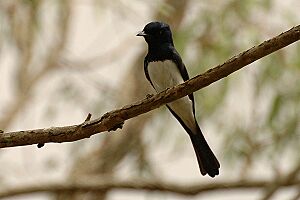Satin flycatcher facts for kids
Quick facts for kids Satin flycatcher |
|
|---|---|
 |
|
| Conservation status | |
| Scientific classification | |
| Genus: |
Myiagra
|
| Species: |
cyanoleuca
|
| Synonyms | |
|
|
The satin flycatcher (Myiagra cyanoleuca) is a small, colorful bird found in Australia. Male satin flycatchers have shiny blue-black feathers and white bellies. Females look different with their bright orange throats. These birds mostly breed in south-eastern Tasmania and Australia. Sadly, their numbers are decreasing because of predators like the Red Fox and the loss of their natural homes. Sometimes, they can even be seen in New Zealand.
Contents
About the Satin Flycatcher
What's in a Name?
The scientific name for the satin flycatcher is Myiagra cyanoleuca. The name Myiagra comes from ancient Greek words meaning "fly" and "seize." This makes sense because they catch flies! The second part, cyanoleuca, means "blue" and "white," which describes the male bird's colors.
The satin flycatcher belongs to a bird family called Monarchidae, also known as Monarchs. This family includes about 100 types of small, passerine (perching) birds. Most of them eat insects. Monarch birds live in many parts of the world, including Africa, Asia, and the Pacific islands.
Meet the Myiagra Birds
The Myiagra group of birds is special within the Monarch family. Males and females often look very different, which is called sexual dimorphism. Most Myiagra birds have black beaks and orange mouths. The males often have shiny, glossy feathers. These birds are mostly found in the Australasia region, especially in Australia, New Zealand, and other pacific islands.
The male satin flycatcher stands out with its deep blue and white feathers. These feathers have a shiny, "satin" look. Other similar birds include the Broad-billed flycatcher and the Leaden flycatcher. However, the satin flycatcher is more common in south-eastern Australia. The other two are found more in Queensland and the Northern Territory.
What Does a Satin Flycatcher Look Like?
The satin flycatcher is a small bird, about 17 centimeters (6.7 inches) tall. It weighs around 17 grams (0.6 ounces), which is about as much as a few coins. They have a small, sharp beak perfect for catching tiny insects.
Male and female satin flycatchers look quite different:
- Males: They are a glossy black-blue color with a white belly. They also have a small crest on their head.
- Females: They are a dusty brown-grey color. They have a bright orange chest and throat, with a white belly.
These birds stand upright. Their tail feathers can spread out like a fan.
Where Do Satin Flycatchers Live?
Satin flycatchers are most common in south-eastern Australia. They like to breed there when the weather is warm. However, some live all year round on the east coast of Australia, in New South Wales, Queensland, and even Papua New Guinea. They also live along the southern coast of Australia, reaching into South Australia. Sometimes, they visit New Zealand.
Life Cycle and Reproduction
Breeding Habits
Satin flycatchers travel to south-east Australia in November to breed. They stay there until early January. During the breeding season, they form pairs and work together to raise their young.
These birds prefer to build their nests in tall Eucalyptus trees. They choose high branches, usually between 5 and 25 meters (16 to 82 feet) off the ground. They often build nests in the same areas year after year.
Eggs and Nests
Female satin flycatchers lay two to three eggs. The eggs are greenish-blue with brown spots. Their nests are very neat, built from bark, spider webs, and moss.
Images for kids



